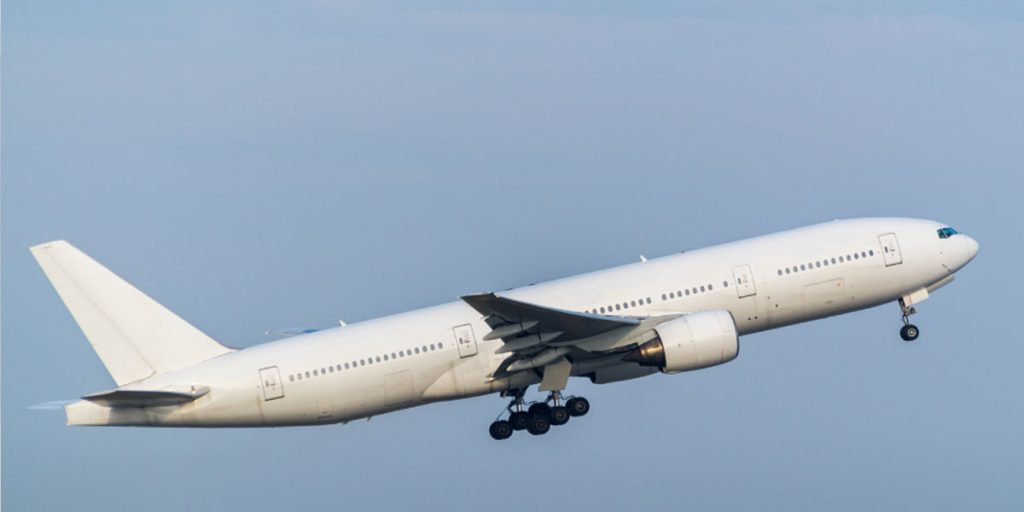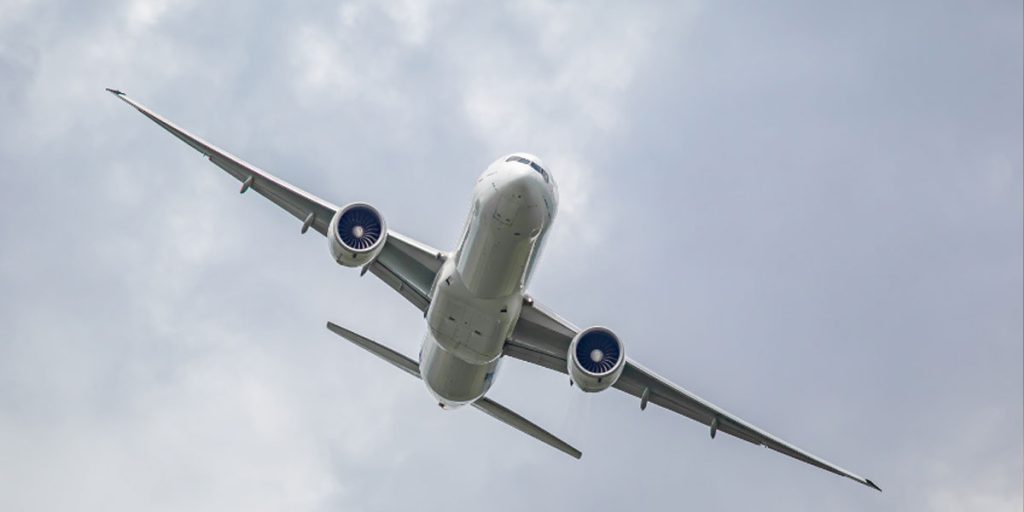An empty Boeing 777 weighs approximately 307,500 pounds (139,500 kilograms). A fully loaded 777 can weigh up to 775,000 pounds (351,500 kilograms).
The Boeing 777, a long-range, wide-body twin-engine jet airliner, is renowned for its large carrying capacity and efficiency.
It’s a popular choice among airlines for international travel due to its impressive range and comfortable cabin layout.
The weight of a 777 varies based on the specific model and customer configurations, which can include seating arrangements, onboard amenities, and cargo.
As one of the most recognizable aircraft in the sky, the 777 series continues to be a vital part of modern commercial air travel, boasting a blend of engineering excellence and technological innovation.
Its weight plays a critical role in its performance, influencing aspects such as fuel efficiency, range, and payload capacity.
The Titan Of The Skies: Boeing 777

The Boeing 777 stands as a marvel in aviation history. Known for its sheer size and power, this twin-engine jet has earned the title of the Titan of the Skies.
Passengers love its comfort. Pilots praise its performance. The 777 has become a favorite for long-haul flights across the globe.
Birth Of The Boeing 777
In the late 1980s, Boeing foresaw a new market. The demand for a large, long-range, twin-engine jet was clear. Boeing aimed high.
They gathered ideas from pilots, engineers, and customers. This collaboration birthed the first Boeing 777. It took to the skies in 1994. Its impact was instant.
The aviation world saw a new leader in the long-haul segment.
Key Features Defining The 777
The Boeing 777’s design is a blend of technology and comfort. Below are the key features that define this aircraft:
- Massive Size: Wide cabin, large wingspan
- Advanced Technology: Glass cockpit, fly-by-wire controls
- Powerful Engines: Among the most powerful jet engines
| Weight Class | Weight (in pounds) | Weight (in kilograms) |
|---|---|---|
| Maximum Takeoff Weight | 775,000 | 351,534 |
| Empty Weight | 304,500 | 138,100 |
The 777 is built for distance and efficiency. Its weight reflects its capabilities. From economy to safety, the 777 excels. Airlines trust it for its reliability. The 777 is certainly a Titan of the Skies.
Breaking Down The 777’s Weight
Let’s dive into the details of a Boeing 777’s weight. Understanding these numbers is crucial for engineers and aviation enthusiasts.
There are different types of weights to consider. Each type tells us something special about this airplane.
Basic Structure Weight
The structure of a Boeing 777 includes the body and wings. Without fuel, cargo, or people, this is the basic weight.
It’s like the skeleton of the plane. This number is huge and shows us how much material Boeing uses. Here’s a look at the different parts:
- Fuselage: The main body where people sit.
- Wings: These help the plane lift off the ground.
- Empennage: The tail section for steering.
- Landing Gear: The wheels for takeoff and landing.
- Engines: They provide power to fly.
A Boeing 777’s basic structure weight is often around 160,000 pounds. It’s like the weight of 40 big elephants!
Operational Weight
The operational weight is higher. It includes the basic structure plus essential items for a flight. These items make the plane ready to go.
Things like the crew, food, and water add up. Fuel is not included yet. Here’s what adds to the basic weight:
| Item | Additional Weight |
|---|---|
| Crew Members: | A few hundred pounds. |
| Food and Beverages: | Varies by flight. |
| Emergency Equipment: | Required for safety. |
| Water and Wastes: | For onboard facilities. |
With everything onboard except fuel, a Boeing 777 has an operational weight of approximately 300,000 pounds. That’s like 75 cars!
Variations Of The 777 Family

Do you ever wonder about the heft of the mighty 777 aircraft? These flying titans cover the globe, and their weights reflect their massive capabilities.
Let’s dive into the diverse 777 family and discover how much each model brings to the tarmac.
The 777-200 Model
The Boeing 777-200 is a marvel of aviation. It’s the original model that started the 777 family. It can carry hundreds of passengers across oceans and continents.
Key facts about the 777-200:
- Standard weight: around 297,550 pounds when empty
- Max takeoff weight: up to 545,000 pounds
- Length: spans 209 feet 1 inch
Extended Range And The 777-300
Boeing expanded the 777 family with two stars; the 777-200ER and 777-300. Both are long-range champs with robust carrying capabilities.
| Model | Empty Weight | Max Takeoff Weight | Length |
|---|---|---|---|
| 777-200ER | 307,000 pounds | 656,000 pounds | 209 feet 1 inch |
| 777-300 | 353,800 pounds | 660,000 pounds | 242 feet 4 inches |
The 777-200ER, or Extended Range, flies further with more fuel onboard. The 777-300 stretches out to fit more passengers while maintaining the 777’s signature performance.
Factors Influencing Aircraft Weight
Understanding how much a Boeing 777 weighs is not as straightforward as it might seem. An array of factors determines the final weight of an aircraft at any given time.
From the amount of fuel to the number of passengers and cargo, the actual weight shifts constantly. Let’s explore the significant elements that affect a 777’s heft.
Fuel As A Weight Variable
Fuel is a major weight component for any aircraft, and its quantity can significantly influence the overall mass.
Airlines meticulously calculate the required fuel for each journey. This ensures safety and efficiency during flight. The below points highlight why fuel is such a critical weight variable:
- Volume: More volume equals more weight.
- Distance: Longer trips need more fuel.
- Alternate Airports: Extra fuel may be required for diversions.
- Weather: Poor conditions could increase fuel needs.
A Boeing 777’s fuel capacity can reach up to 47,890 gallons. With fuel weighing about 6.7 pounds per gallon, it’s evident how fuel quantity can affect total aircraft weight significantly.
Passenger And Cargo Load
Next to fuel, the number of passengers and amount of cargo are crucial in shaping a plane’s weight. Each passenger and their luggage mean added pounds.
The same goes for cargo. Below is a breakdown of how these components influence weight:
| Component | Weight Influence |
|---|---|
| Passengers | Varies with number and size |
| Baggage | Depends on amount and restrictions |
| Cargo | Shifts with volume and type |
A full passenger load and cargo hold can add significant weight to the 777. Each aspect is calculated to ensure secure and efficient travel.
When the Boeing 777 reaches its maximum capacity, careful weight distribution becomes critical.
Comparisons With Other Aeronautical Giants
When it comes to modern aviation marvels, the Boeing 777 is a heavyweight champion. Its impressive size and power compare with some of the most iconic aircraft in the sky.
Let’s explore how the 777 measures up next to other aeronautical giants.
The 777 Vs. Airbus A350
The Boeing 777 and Airbus A350 are two giants in the sky. Both planes can fly long distances. They carry many passengers. But they have different weights. This can affect how they fly.
| Aircraft | Empty Weight | Maximum Takeoff Weight |
|---|---|---|
| Boeing 777-300ER | 370,000 lbs (167,829 kg) | 775,000 lbs (351,534 kg) |
| Airbus A350-900 | 282,100 lbs (127,975 kg) | 617,300 lbs (280,000 kg) |
The 777 is heavier. It can take more weight when it flies. This makes it strong for carrying cargo and people over oceans.
Jumbo Jets: 777 And The 747
The 777 and 747 are like family. They both come from Boeing. They are both very big. But the 747 has been flying longer. Because of this, many people know it as the “Queen of the Skies”.
- The 747 is bigger in size. It has two floors for people.
- Both planes carry lots of passengers and cargo.
- The 747 can weigh more than the 777 when it is full.
Here’s a quick look at their weights:
- Boeing 777-300ER: Maximum takeoff weight is 775,000 lbs (351,534 kg).
- Boeing 747-8: It can weigh up to 987,000 lbs (447,696 kg) when ready for takeoff.
These giants of the sky show what humans can do. They are big. They are heavy. They fly far and fast. They carry people all around the world.
The Future Of Heavy Aircraft
The landscape of aviation is soaring to new heights with advancements in heavyweight aircraft. The colossal Boeing 777 series has continuously set standards for capacity and range.
Yet, as the skies call for efficiency and sustainability, what does the future hold for these giants of the air?
Evolution Of The Boeing 777x
Boeing’s 777X is a marvel of modern engineering. This latest iteration takes the trusted design of its predecessor and evolves it with cutting-edge features.
With composite wings that fold at the tips and powerful GE9X engines, it represents the pinnacle of what heavyweight aircraft can achieve.
The 777X series includes the 777-8 and the nearly 77 meters long 777-9 variant, which boasts an impressive weight of 775,000 pounds at maximum takeoff.
| Model | Length | Wingspan | Max Takeoff Weight |
|---|---|---|---|
| 777-8 | 69 meters | 71.8 meters | 775,000 pounds |
| 777-9 | 76.7 meters | 71.8 meters | 775,000 pounds |
Sustainable Weight Reduction Technologies
Aircraft weight is a critical factor for fuel efficiency and environmental performance. Innovators in the aerospace industry are now focusing on this with sustainable weight reduction technologies.
Companies are experimenting with lighter materials like titanium and carbon-fiber-reinforced polymer (CFRP) to shed pounds from the plane’s overall mass.
- Advanced composite materials: Reduce weight, maintain strength.
- 3D printed components: Custom parts that weigh less.
- Next-generation aircraft design: Streamlining structures to minimize weight.
With initiatives such as the Clean Sky program and research into electric propulsion, the industry is not only trimming down aircraft but also paving the way for greener skies.
The Boeing 777X, poised to be a testbed for such advancements, embodies the ongoing transformation of heavy aircraft.
It maintains hefty lifting capacities while embracing technologies that could lead to lighter, cleaner, and more efficient air travel.
FAQ About the Weight of a Boeing 777
What Is The Weight Of A Boeing 777?
The Boeing 777 commercial aircraft has a maximum takeoff weight ranging from 545,000 to 775,000 pounds, depending on the model variant.
How Does The 777’s Weight Impact Fuel Consumption?
The weight of a 777 directly influences fuel consumption. Heavier aircraft require more fuel for takeoff, cruising, and landing, impacting overall efficiency and operating costs.
Can The Weight Of A 777 Vary?
Yes, the weight of a Boeing 777 can vary based on the specific model, payload, fuel load, and the presence of onboard amenities.
What’s The Empty Weight Of A 777 Aircraft?
The empty weight, also known as the operating empty weight (OEW), of a Boeing 777 ranges from 300,000 to 400,000 pounds, varying by model and configuration.
Conclusion
Understanding a Boeing 777’s weight is crucial for appreciating its engineering marvel. A fully loaded 777 can tip the scales at an impressive 775,000 pounds.
It’s this impressive heft that underscores the expertise behind its design, allowing it to traverse vast skies.
Future enthusiasts and aviation professionals alike will continue to marvel at this feat of modern aeronautics.
